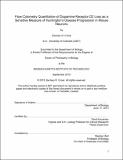Flow cytometry quantitation of dopamine receptor D2 loss as a sensitive measure of Huntington's Disease progression in mouse neurons
Author(s)
Crook, Zachary R. (Zachary Ryan)
DownloadFull printable version (29.13Mb)
Other Contributors
Massachusetts Institute of Technology. Department of Biology.
Advisor
David Housman.
Terms of use
Metadata
Show full item recordAbstract
Mouse models of Huntington's Disease (HD) are often used for testing potential therapeutic compounds. These experiments require substantial investments in time and resources, and have yet to produce any intervention that has made a significant impact on disease progression in the clinic. In evaluating potential therapeutics, there is an unmet need for a rapid, highly quantitative measure of disease progression in the HD mouse model brain. Such an assay would help make preclinical trials more efficient. To address this need, I have developed a novel technique for measuring the progression of transcriptional dysregulation, a phenotype with substantial similarities between mouse models and patients. Specifically, utilizing mice that drive GFP expression under the control of one such dysregulated gene (Drd2), I have improved on previous protocols for the isolation and characterization of adult neurons by flow cytometry. Drd2 is a well-studied marker of a particularly vulnerable population in HD patients, the indirect medium spiny neurons of the striatum. Using this technique, I have demonstrated the ability to accurately and rapidly quantitate Drd2 transcript levels, as measured by Drd2 GFP (D2GFP) fluorescence, in several strains of HD model mice. This D2GFP loss is particularly robust, with sufficient power to allow subtle, statistically significant alterations to be observed with very small cohorts. Furthermore, the introduction of this D2GFP transgene does not alter the classic HD pathology in these mice. Finally, I show that D2GFP dysregulation can be either induced or ameliorated genetically by delivering transgenes via adeno associated viral vectors, and that a small molecule with only subtle transcriptional effects (cystamine) fails to rescue D2GFP loss. I hope that this system can be of great utility in the validation of effective therapeutic interventions for HD.
Description
Thesis (Ph. D.)--Massachusetts Institute of Technology, Dept. of Biology, 2013. This electronic version was submitted by the student author. The certified thesis is available in the Institute Archives and Special Collections. Cataloged from student-submitted PDF version of thesis. Includes bibliographical references.
Date issued
2013Department
Massachusetts Institute of Technology. Department of BiologyPublisher
Massachusetts Institute of Technology
Keywords
Biology.